belt Abarth 124 Spider 2021 Owner handbook (in English)
[x] Cancel search | Manufacturer: ABARTH, Model Year: 2021, Model line: 124 Spider, Model: Abarth 124 Spider 2021Pages: 224, PDF Size: 3.9 MB
Page 13 of 224
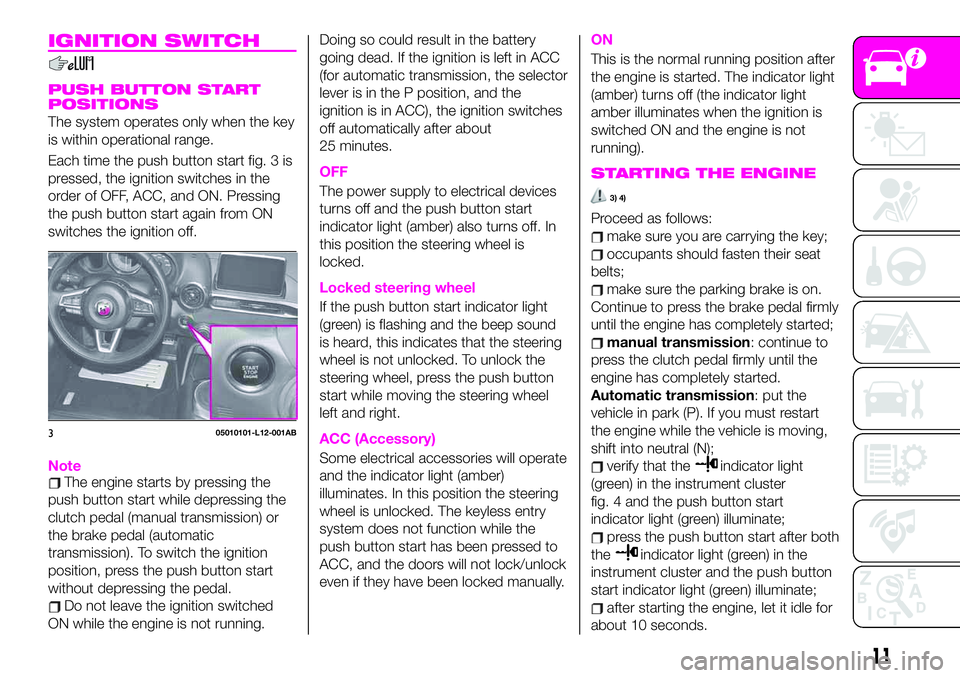
IGNITION SWITCH
PUSH BUTTON START
POSITIONS
The system operates only when the key
is within operational range.
Each time the push button start fig. 3 is
pressed, the ignition switches in the
order of OFF, ACC, and ON. Pressing
the push button start again from ON
switches the ignition off.
NoteThe engine starts by pressing the
push button start while depressing the
clutch pedal (manual transmission) or
the brake pedal (automatic
transmission). To switch the ignition
position, press the push button start
without depressing the pedal.
Do not leave the ignition switched
ON while the engine is not running.Doing so could result in the battery
going dead. If the ignition is left in ACC
(for automatic transmission, the selector
lever is in the P position, and the
ignition is in ACC), the ignition switches
off automatically after about
25 minutes.
OFF
The power supply to electrical devices
turns off and the push button start
indicator light (amber) also turns off. In
this position the steering wheel is
locked.
Locked steering wheel
If the push button start indicator light
(green) is flashing and the beep sound
is heard, this indicates that the steering
wheel is not unlocked. To unlock the
steering wheel, press the push button
start while moving the steering wheel
left and right.
ACC (Accessory)
Some electrical accessories will operate
and the indicator light (amber)
illuminates. In this position the steering
wheel is unlocked. The keyless entry
system does not function while the
push button start has been pressed to
ACC, and the doors will not lock/unlock
even if they have been locked manually.
ON
This is the normal running position after
the engine is started. The indicator light
(amber) turns off (the indicator light
amber illuminates when the ignition is
switched ON and the engine is not
running).
STARTING THE ENGINE
3) 4)
Proceed as follows:
make sure you are carrying the key;
occupants should fasten their seat
belts;
make sure the parking brake is on.
Continue to press the brake pedal firmly
until the engine has completely started;
manual transmission: continue to
press the clutch pedal firmly until the
engine has completely started.
Automatic transmission: put the
vehicle in park (P). If you must restart
the engine while the vehicle is moving,
shift into neutral (N);
verify that theindicator light
(green) in the instrument cluster
fig. 4 and the push button start
indicator light (green) illuminate;
press the push button start after both
the
indicator light (green) in the
instrument cluster and the push button
start indicator light (green) illuminate;
after starting the engine, let it idle for
about 10 seconds.
305010101-L12-001AB
11
Page 22 of 224
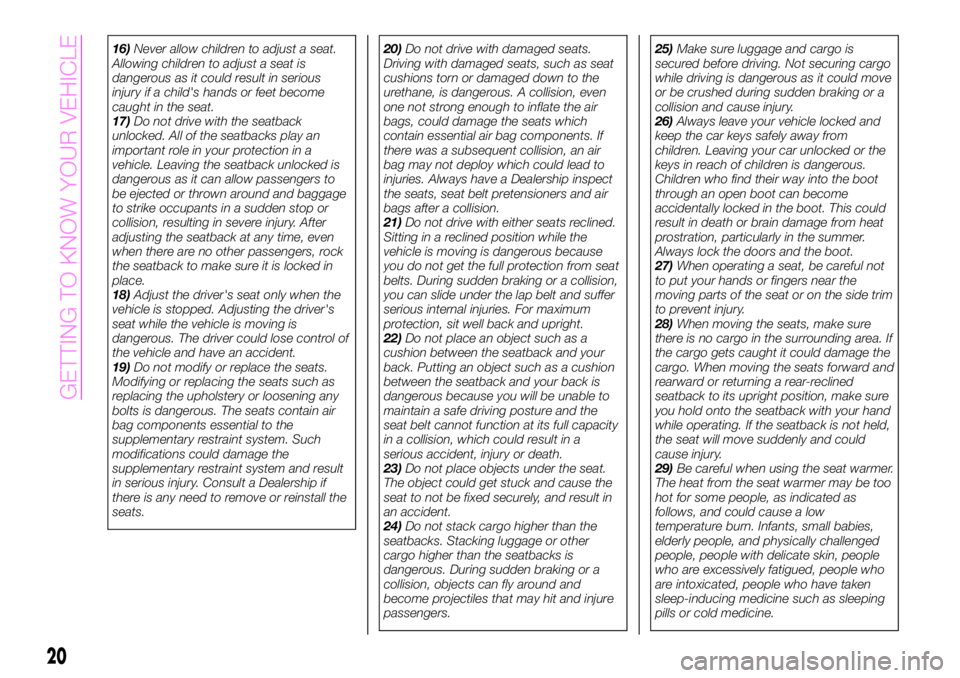
16)Never allow children to adjust a seat.
Allowing children to adjust a seat is
dangerous as it could result in serious
injury if a child's hands or feet become
caught in the seat.
17)Do not drive with the seatback
unlocked. All of the seatbacks play an
important role in your protection in a
vehicle. Leaving the seatback unlocked is
dangerous as it can allow passengers to
be ejected or thrown around and baggage
to strike occupants in a sudden stop or
collision, resulting in severe injury. After
adjusting the seatback at any time, even
when there are no other passengers, rock
the seatback to make sure it is locked in
place.
18)Adjust the driver's seat only when the
vehicle is stopped. Adjusting the driver's
seat while the vehicle is moving is
dangerous. The driver could lose control of
the vehicle and have an accident.
19)Do not modify or replace the seats.
Modifying or replacing the seats such as
replacing the upholstery or loosening any
bolts is dangerous. The seats contain air
bag components essential to the
supplementary restraint system. Such
modifications could damage the
supplementary restraint system and result
in serious injury. Consult a Dealership if
there is any need to remove or reinstall the
seats.20)Do not drive with damaged seats.
Driving with damaged seats, such as seat
cushions torn or damaged down to the
urethane, is dangerous. A collision, even
one not strong enough to inflate the air
bags, could damage the seats which
contain essential air bag components. If
there was a subsequent collision, an air
bag may not deploy which could lead to
injuries. Always have a Dealership inspect
the seats, seat belt pretensioners and air
bags after a collision.
21)Do not drive with either seats reclined.
Sitting in a reclined position while the
vehicle is moving is dangerous because
you do not get the full protection from seat
belts. During sudden braking or a collision,
you can slide under the lap belt and suffer
serious internal injuries. For maximum
protection, sit well back and upright.
22)Do not place an object such as a
cushion between the seatback and your
back. Putting an object such as a cushion
between the seatback and your back is
dangerous because you will be unable to
maintain a safe driving posture and the
seat belt cannot function at its full capacity
in a collision, which could result in a
serious accident, injury or death.
23)Do not place objects under the seat.
The object could get stuck and cause the
seat to not be fixed securely, and result in
an accident.
24)Do not stack cargo higher than the
seatbacks. Stacking luggage or other
cargo higher than the seatbacks is
dangerous. During sudden braking or a
collision, objects can fly around and
become projectiles that may hit and injure
passengers.25)Make sure luggage and cargo is
secured before driving. Not securing cargo
while driving is dangerous as it could move
or be crushed during sudden braking or a
collision and cause injury.
26)Always leave your vehicle locked and
keep the car keys safely away from
children. Leaving your car unlocked or the
keys in reach of children is dangerous.
Children who find their way into the boot
through an open boot can become
accidentally locked in the boot. This could
result in death or brain damage from heat
prostration, particularly in the summer.
Always lock the doors and the boot.
27)When operating a seat, be careful not
to put your hands or fingers near the
moving parts of the seat or on the side trim
to prevent injury.
28)When moving the seats, make sure
there is no cargo in the surrounding area. If
the cargo gets caught it could damage the
cargo. When moving the seats forward and
rearward or returning a rear-reclined
seatback to its upright position, make sure
you hold onto the seatback with your hand
while operating. If the seatback is not held,
the seat will move suddenly and could
cause injury.
29)Be careful when using the seat warmer.
The heat from the seat warmer may be too
hot for some people, as indicated as
follows, and could cause a low
temperature burn. Infants, small babies,
elderly people, and physically challenged
people, people with delicate skin, people
who are excessively fatigued, people who
are intoxicated, people who have taken
sleep-inducing medicine such as sleeping
pills or cold medicine.
20
GETTING TO KNOW YOUR VEHICLE
Page 48 of 224
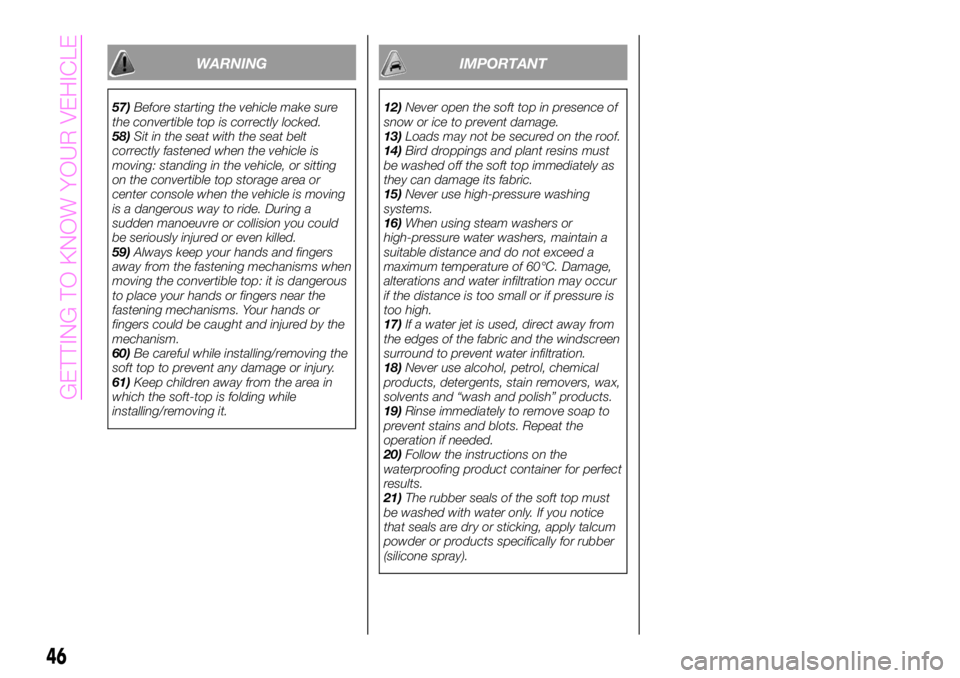
WARNING
57)Before starting the vehicle make sure
the convertible top is correctly locked.
58)Sit in the seat with the seat belt
correctly fastened when the vehicle is
moving: standing in the vehicle, or sitting
on the convertible top storage area or
center console when the vehicle is moving
is a dangerous way to ride. During a
sudden manoeuvre or collision you could
be seriously injured or even killed.
59)Always keep your hands and fingers
away from the fastening mechanisms when
moving the convertible top: it is dangerous
to place your hands or fingers near the
fastening mechanisms. Your hands or
fingers could be caught and injured by the
mechanism.
60)Be careful while installing/removing the
soft top to prevent any damage or injury.
61)Keep children away from the area in
which the soft-top is folding while
installing/removing it.
IMPORTANT
12)Never open the soft top in presence of
snow or ice to prevent damage.
13)Loads may not be secured on the roof.
14)Bird droppings and plant resins must
be washed off the soft top immediately as
they can damage its fabric.
15)Never use high-pressure washing
systems.
16)When using steam washers or
high-pressure water washers, maintain a
suitable distance and do not exceed a
maximum temperature of 60°C. Damage,
alterations and water infiltration may occur
if the distance is too small or if pressure is
too high.
17)If a water jet is used, direct away from
the edges of the fabric and the windscreen
surround to prevent water infiltration.
18)Never use alcohol, petrol, chemical
products, detergents, stain removers, wax,
solvents and “wash and polish” products.
19)Rinse immediately to remove soap to
prevent stains and blots. Repeat the
operation if needed.
20)Follow the instructions on the
waterproofing product container for perfect
results.
21)The rubber seals of the soft top must
be washed with water only. If you notice
that seals are dry or sticking, apply talcum
powder or products specifically for rubber
(silicone spray).
46
GETTING TO KNOW YOUR VEHICLE
Page 56 of 224
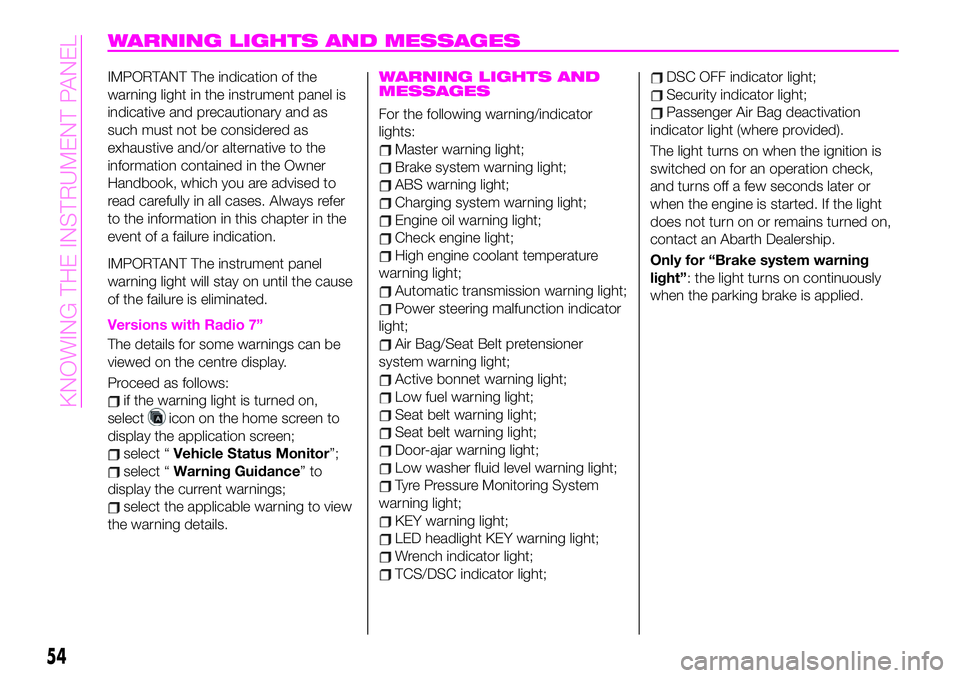
WARNING LIGHTS AND MESSAGES
IMPORTANT The indication of the
warning light in the instrument panel is
indicative and precautionary and as
such must not be considered as
exhaustive and/or alternative to the
information contained in the Owner
Handbook, which you are advised to
read carefully in all cases. Always refer
to the information in this chapter in the
event of a failure indication.
IMPORTANT The instrument panel
warning light will stay on until the cause
of the failure is eliminated.
Versions with Radio 7”
The details for some warnings can be
viewed on the centre display.
Proceed as follows:
if the warning light is turned on,
select
icon on the home screen to
display the application screen;
select “Vehicle Status Monitor”;
select “Warning Guidance”to
display the current warnings;
select the applicable warning to view
the warning details.
WARNING LIGHTS AND
MESSAGES
For the following warning/indicator
lights:
Master warning light;
Brake system warning light;
ABS warning light;
Charging system warning light;
Engine oil warning light;
Check engine light;
High engine coolant temperature
warning light;
Automatic transmission warning light;
Power steering malfunction indicator
light;
Air Bag/Seat Belt pretensioner
system warning light;
Active bonnet warning light;
Low fuel warning light;
Seat belt warning light;
Seat belt warning light;
Door-ajar warning light;
Low washer fluid level warning light;
Tyre Pressure Monitoring System
warning light;
KEY warning light;
LED headlight KEY warning light;
Wrench indicator light;
TCS/DSC indicator light;
DSC OFF indicator light;
Security indicator light;
Passenger Air Bag deactivation
indicator light (where provided).
The light turns on when the ignition is
switched on for an operation check,
and turns off a few seconds later or
when the engine is started. If the light
does not turn on or remains turned on,
contact an Abarth Dealership.
Only for “Brake system warning
light”: the light turns on continuously
when the parking brake is applied.
54
KNOWING THE INSTRUMENT PANEL
Page 61 of 224

Warning light What it means What to do
AIR BAG / SEAT BELT PRETENSIONER
SYSTEM WARNING
A system malfunction is indicated if the
warning light constantly flashes, constantly
illuminates or does not illuminate at all when
the ignition is switched ON. If any of these
occur, contact an Abarth Dealership as soon
as possible. The system may not operate in an
accident.
62)
Contact an Abarth Dealership as soon as
possible. The system may not operate in an
accident.
59
Page 72 of 224

Warning light (red color) on dashboard trim
Warning light What it means What to do
SEAT BELT WARNING LIGHT
The seat belt warning light turns on if the
driver or passenger's seat is occupied and the
seat belt is not fastened with the ignition
switched ON.
If the driver or passenger's seat belt is
unfastened (only when the passenger seat is
occupied) and the vehicle is driven at a speed
faster than about 20 km/h, the warning light
flashes. After a short time, the LED stops
flashing, but remains illuminated.
If a seat belt remains unfastened, the LED
flashes again for a given period of time.
If the driver or passenger's seat belt is
unfastened after the LED turns on, and the
vehicle speed exceeds 20 km/h, the LED
flashes again.
Passenger occupant classification
system: to allow the passenger occupant
classification sensor to function properly, do
not place and sit on an additional seat cushion
on the passenger's seat. The sensor may not
function properly because the additional seat
cushion could cause sensor interference.
Warning light (amber color) on dashboard trim
Warning light What it means What to do
PASSENGER AIR BAG DEACTIVATION
INDICATOR LIGHT
The light turns on when the ignition is
switched on for an operation check, and turns
off a few seconds later or when the engine is
started. If the light does not turn on or remains
turned on, contact an Abarth Dealership.If the light does not turn on or remains turned
on, contact an Abarth Dealership.
70
KNOWING THE INSTRUMENT PANEL
Page 73 of 224
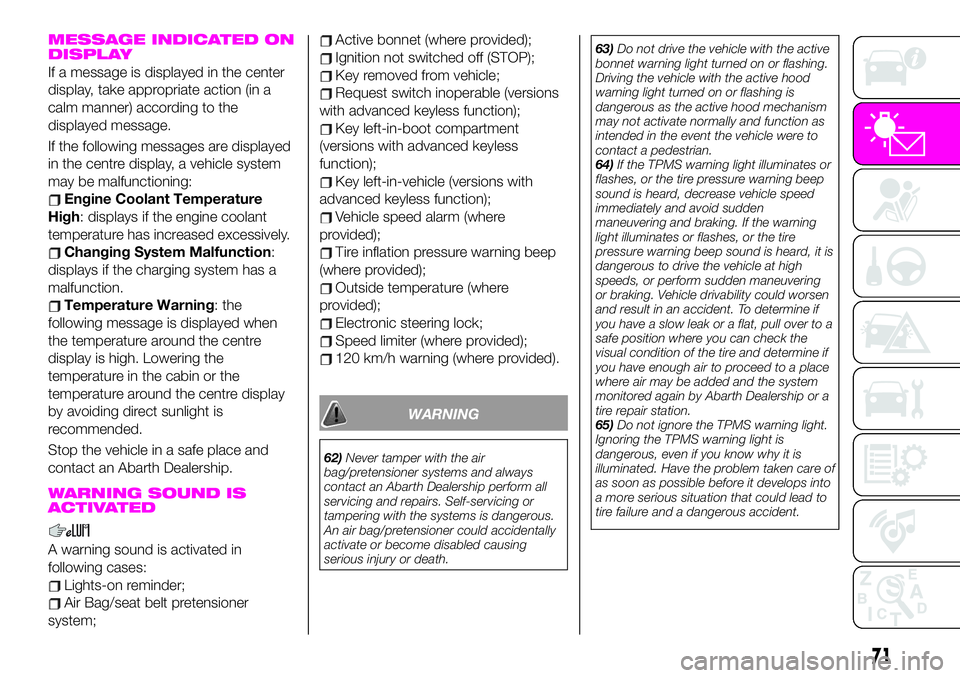
MESSAGE INDICATED ON
DISPLAY
If a message is displayed in the center
display, take appropriate action (in a
calm manner) according to the
displayed message.
If the following messages are displayed
in the centre display, a vehicle system
may be malfunctioning:
Engine Coolant Temperature
High: displays if the engine coolant
temperature has increased excessively.
Changing System Malfunction:
displays if the charging system has a
malfunction.
Temperature Warning: the
following message is displayed when
the temperature around the centre
display is high. Lowering the
temperature in the cabin or the
temperature around the centre display
by avoiding direct sunlight is
recommended.
Stop the vehicle in a safe place and
contact an Abarth Dealership.
WARNING SOUND IS
ACTIVATED
A warning sound is activated in
following cases:
Lights-on reminder;
Air Bag/seat belt pretensioner
system;
Active bonnet (where provided);
Ignition not switched off (STOP);
Key removed from vehicle;
Request switch inoperable (versions
with advanced keyless function);
Key left-in-boot compartment
(versions with advanced keyless
function);
Key left-in-vehicle (versions with
advanced keyless function);
Vehicle speed alarm (where
provided);
Tire inflation pressure warning beep
(where provided);
Outside temperature (where
provided);
Electronic steering lock;
Speed limiter (where provided);
120 km/h warning (where provided).
WARNING
62)Never tamper with the air
bag/pretensioner systems and always
contact an Abarth Dealership perform all
servicing and repairs. Self-servicing or
tampering with the systems is dangerous.
An air bag/pretensioner could accidentally
activate or become disabled causing
serious injury or death.63)Do not drive the vehicle with the active
bonnet warning light turned on or flashing.
Driving the vehicle with the active hood
warning light turned on or flashing is
dangerous as the active hood mechanism
may not activate normally and function as
intended in the event the vehicle were to
contact a pedestrian.
64)If the TPMS warning light illuminates or
flashes, or the tire pressure warning beep
sound is heard, decrease vehicle speed
immediately and avoid sudden
maneuvering and braking. If the warning
light illuminates or flashes, or the tire
pressure warning beep sound is heard, it is
dangerous to drive the vehicle at high
speeds, or perform sudden maneuvering
or braking. Vehicle drivability could worsen
and result in an accident. To determine if
you have a slow leak or a flat, pull over to a
safe position where you can check the
visual condition of the tire and determine if
you have enough air to proceed to a place
where air may be added and the system
monitored again by Abarth Dealership or a
tire repair station.
65)Do not ignore the TPMS warning light.
Ignoring the TPMS warning light is
dangerous, even if you know why it is
illuminated. Have the problem taken care of
as soon as possible before it develops into
a more serious situation that could lead to
tire failure and a dangerous accident.
71
Page 74 of 224
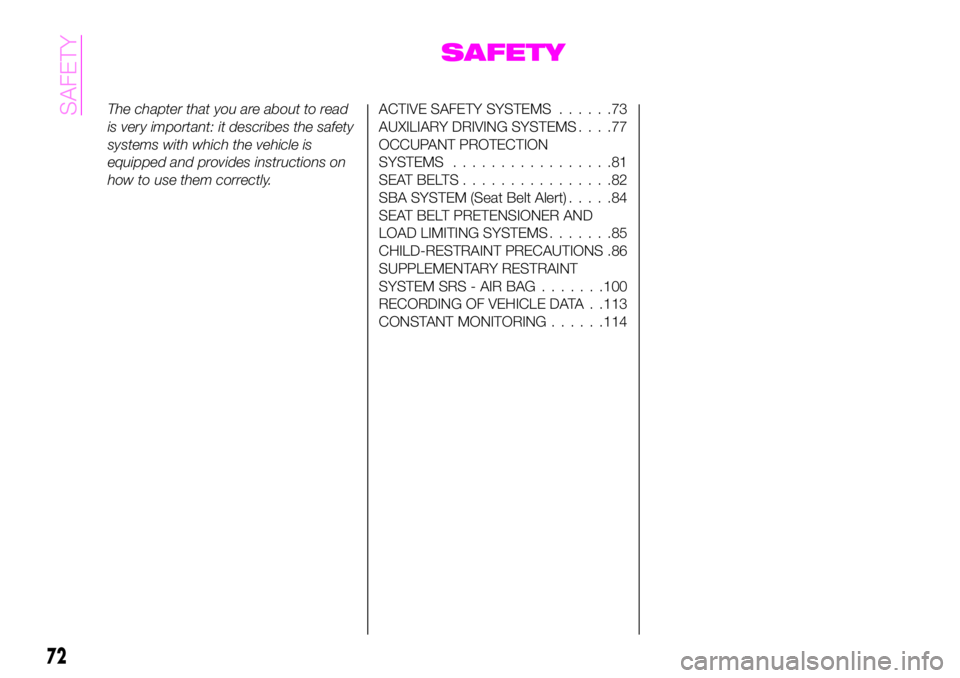
SAFETY
The chapter that you are about to read
is very important: it describes the safety
systems with which the vehicle is
equipped and provides instructions on
how to use them correctly.ACTIVE SAFETY SYSTEMS......73
AUXILIARY DRIVING SYSTEMS....77
OCCUPANT PROTECTION
SYSTEMS.................81
SEATBELTS................82
SBA SYSTEM (Seat Belt Alert).....84
SEAT BELT PRETENSIONER AND
LOAD LIMITING SYSTEMS.......85
CHILD-RESTRAINT PRECAUTIONS .86
SUPPLEMENTARY RESTRAINT
SYSTEM SRS - AIR BAG.......100
RECORDING OF VEHICLE DATA . .113
CONSTANT MONITORING......114
72
SAFETY
Page 83 of 224
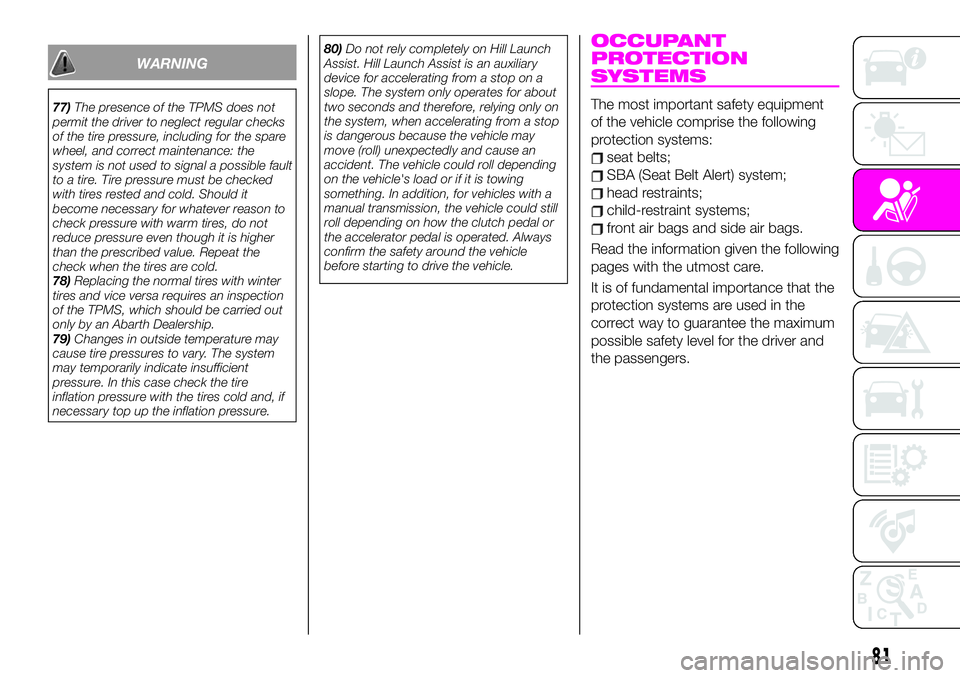
WARNING
77)The presence of the TPMS does not
permit the driver to neglect regular checks
of the tire pressure, including for the spare
wheel, and correct maintenance: the
system is not used to signal a possible fault
to a tire. Tire pressure must be checked
with tires rested and cold. Should it
become necessary for whatever reason to
check pressure with warm tires, do not
reduce pressure even though it is higher
than the prescribed value. Repeat the
check when the tires are cold.
78)Replacing the normal tires with winter
tires and vice versa requires an inspection
of the TPMS, which should be carried out
only by an Abarth Dealership.
79)Changes in outside temperature may
cause tire pressures to vary. The system
may temporarily indicate insufficient
pressure. In this case check the tire
inflation pressure with the tires cold and, if
necessary top up the inflation pressure.80)Do not rely completely on Hill Launch
Assist. Hill Launch Assist is an auxiliary
device for accelerating from a stop on a
slope. The system only operates for about
two seconds and therefore, relying only on
the system, when accelerating from a stop
is dangerous because the vehicle may
move (roll) unexpectedly and cause an
accident. The vehicle could roll depending
on the vehicle's load or if it is towing
something. In addition, for vehicles with a
manual transmission, the vehicle could still
roll depending on how the clutch pedal or
the accelerator pedal is operated. Always
confirm the safety around the vehicle
before starting to drive the vehicle.
OCCUPANT
PROTECTION
SYSTEMS
The most important safety equipment
of the vehicle comprise the following
protection systems:
seat belts;
SBA (Seat Belt Alert) system;
head restraints;
child-restraint systems;
front air bags and side air bags.
Read the information given the following
pages with the utmost care.
It is of fundamental importance that the
protection systems are used in the
correct way to guarantee the maximum
possible safety level for the driver and
the passengers.
81
Page 84 of 224
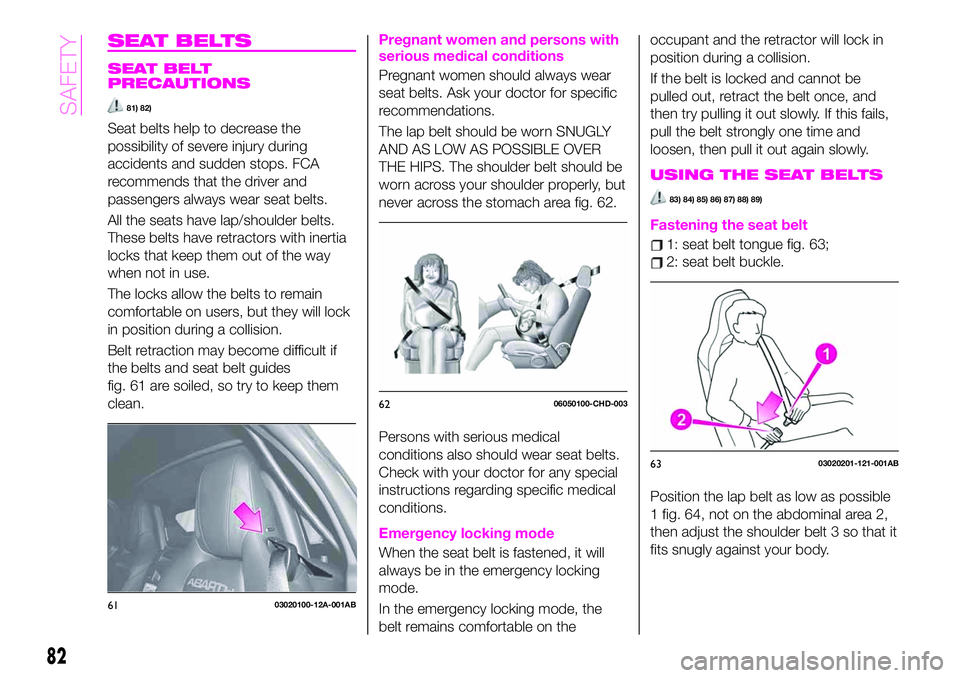
SEAT BELTS
SEAT BELT
PRECAUTIONS
81) 82)
Seat belts help to decrease the
possibility of severe injury during
accidents and sudden stops. FCA
recommends that the driver and
passengers always wear seat belts.
All the seats have lap/shoulder belts.
These belts have retractors with inertia
locks that keep them out of the way
when not in use.
The locks allow the belts to remain
comfortable on users, but they will lock
in position during a collision.
Belt retraction may become difficult if
the belts and seat belt guides
fig. 61 are soiled, so try to keep them
clean.
Pregnant women and persons with
serious medical conditions
Pregnant women should always wear
seat belts. Ask your doctor for specific
recommendations.
The lap belt should be worn SNUGLY
AND AS LOW AS POSSIBLE OVER
THE HIPS. The shoulder belt should be
worn across your shoulder properly, but
never across the stomach area fig. 62.
Persons with serious medical
conditions also should wear seat belts.
Check with your doctor for any special
instructions regarding specific medical
conditions.
Emergency locking mode
When the seat belt is fastened, it will
always be in the emergency locking
mode.
In the emergency locking mode, the
belt remains comfortable on theoccupant and the retractor will lock in
position during a collision.
If the belt is locked and cannot be
pulled out, retract the belt once, and
then try pulling it out slowly. If this fails,
pull the belt strongly one time and
loosen, then pull it out again slowly.
USING THE SEAT BELTS
83) 84) 85) 86) 87) 88) 89)
Fastening the seat belt
1: seat belt tongue fig. 63;
2: seat belt buckle.
Position the lap belt as low as possible
1 fig. 64, not on the abdominal area 2,
then adjust the shoulder belt 3 so that it
fits snugly against your body.
6103020100-12A-001AB
6206050100-CHD-003
6303020201-121-001AB
82
SAFETY